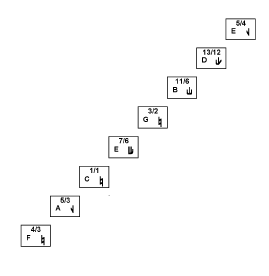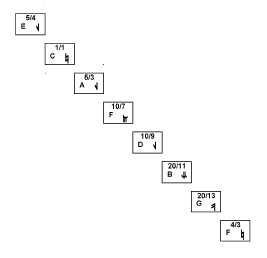This is a work in progress…
Today’s installment has a kind of fanfare sound to it, ending with the trumpets and trombones loud and triumphant. The scale is a major scale, but based on the utonality. Picture a 15-limit Partch tonality diamond with the center on middle “C”. 
The overtones go up and to the right, the undertones go down and to the right. Go down the undertone series from C 1/1 to A 8/5 to F 4/3. Then you can go up the overtone series on F 4/3. This would make a sort of major scale.

- F 4/3
- G 3/2
- A 5/3
- B 11/6
- C 1/1
- D 13/12
- two different sevenths (E 7/6 and E 5/4)
- F 4/3
On the right is the scale derived from the tonality diamond. I use that scale all the time in my just intonation music. I love the stong major third a 5:4 above the root, the solid major second at 9:8, a clearly just seventh at 7:4, and that wierd 11:8. Play them together and you get the traditional just sound, complete with a solid root combination tone. Play the even overtones and the combination tone jumps an octave, play the odds and it drops back down. Lots to play with here.
But consider another major scale hidden inside the diamond. Go up the overtone series from C 1/1 to E 5/4, then down the undertone series from there to the right. Pull out another “major” scale that uses the notes shown below on the right, in the order listed on the left.
- F 4/3
- two different seconds (F 10/7, G 20/13)
- A 5/3
- B 20/11
- C 1/1
- D 10/9
- E 5/4
- F 4/3
This is a scale that also has a lot of material. You have a solid just major third and fifth, providing the traditional just 4:5:6 of the overtone scale. Then you have two different seconds, a major and a minor, neither of which are like to 12 tone equal major or minor seconds. The sixth is a sweet minor third (6:5) below the root. If you need it, there is a minor third chord based on A 5/3, C 1/1, E 5/4 inside the scale. The fourth note in the scale has the sting of the 11th undertone. The seventh is the traditional 15:8 above the root, for those major seventh heaven moments.

